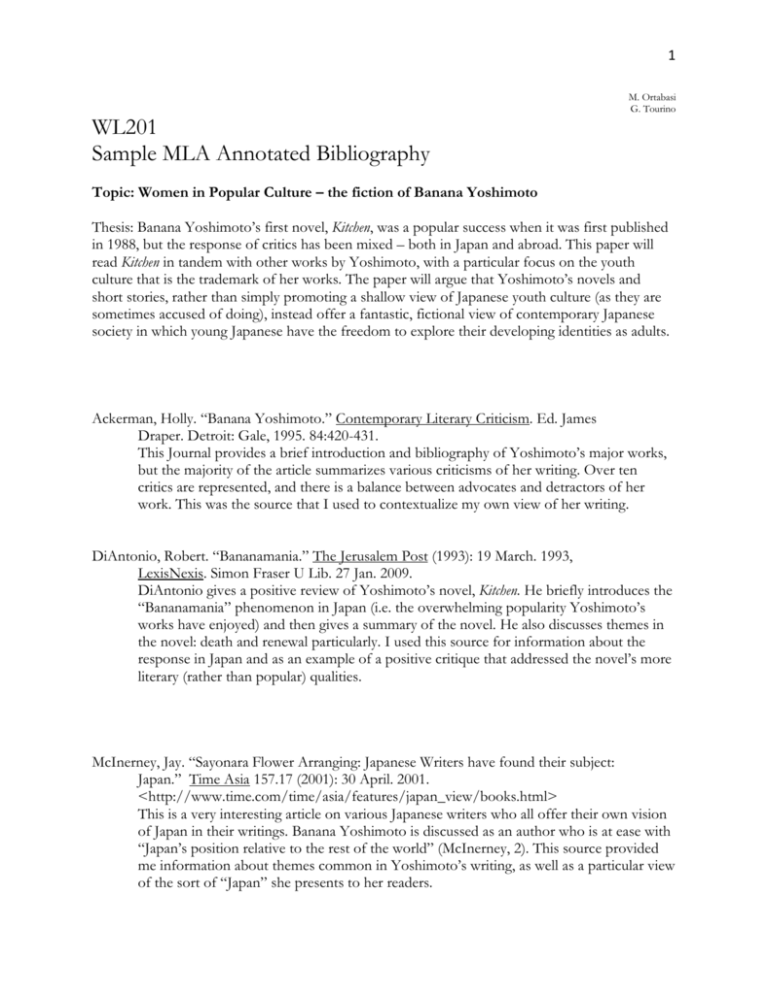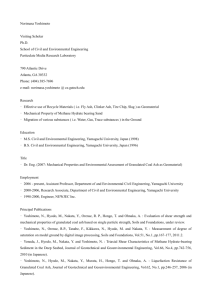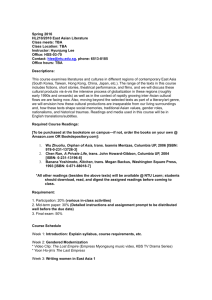WL 201 sample annotated bibliography
advertisement

1 M. Ortabasi G. Tourino WL201 Sample MLA Annotated Bibliography Topic: Women in Popular Culture – the fiction of Banana Yoshimoto Thesis: Banana Yoshimoto’s first novel, Kitchen, was a popular success when it was first published in 1988, but the response of critics has been mixed – both in Japan and abroad. This paper will read Kitchen in tandem with other works by Yoshimoto, with a particular focus on the youth culture that is the trademark of her works. The paper will argue that Yoshimoto’s novels and short stories, rather than simply promoting a shallow view of Japanese youth culture (as they are sometimes accused of doing), instead offer a fantastic, fictional view of contemporary Japanese society in which young Japanese have the freedom to explore their developing identities as adults. Ackerman, Holly. “Banana Yoshimoto.” Contemporary Literary Criticism. Ed. James Draper. Detroit: Gale, 1995. 84:420-431. This Journal provides a brief introduction and bibliography of Yoshimoto’s major works, but the majority of the article summarizes various criticisms of her writing. Over ten critics are represented, and there is a balance between advocates and detractors of her work. This was the source that I used to contextualize my own view of her writing. DiAntonio, Robert. “Bananamania.” The Jerusalem Post (1993): 19 March. 1993, LexisNexis. Simon Fraser U Lib. 27 Jan. 2009. DiAntonio gives a positive review of Yoshimoto’s novel, Kitchen. He briefly introduces the “Bananamania” phenomenon in Japan (i.e. the overwhelming popularity Yoshimoto’s works have enjoyed) and then gives a summary of the novel. He also discusses themes in the novel: death and renewal particularly. I used this source for information about the response in Japan and as an example of a positive critique that addressed the novel’s more literary (rather than popular) qualities. McInerney, Jay. “Sayonara Flower Arranging: Japanese Writers have found their subject: Japan.” Time Asia 157.17 (2001): 30 April. 2001. <http://www.time.com/time/asia/features/japan_view/books.html> This is a very interesting article on various Japanese writers who all offer their own vision of Japan in their writings. Banana Yoshimoto is discussed as an author who is at ease with “Japan’s position relative to the rest of the world” (McInerney, 2). This source provided me information about themes common in Yoshimoto’s writing, as well as a particular view of the sort of “Japan” she presents to her readers. 2 Maynard, Senko. “A Poetics of Grammar: Playing with narrative perspectives and voices in Japanese and translation texts.” Poetics 26 (1999): 115-141. This article, among other things, discusses the “translatability” of Yoshimoto’s texts, and the difficulties that exist. Although the article is complicated and goes very much into the linguistics of translation, I was able to take from it some general information about the difficulties of translating from Japanese to English. It is not directly pertinent to my paper, but gave me some insight into the differences between reading the text in the original and in translation. Parker, Patricia. “World literature in review: Japan.” World Literature Today 69.4 (1995): 877, Academic Search Premier. EBSCO. Simon Fraser U Lib. 27 Jan. 2009. This is a review of Yoshimoto’s book Lizard, which is the compilation of short stories I will discuss in tandem with her novel Kitchen. Parker gives summaries of the short stories and then discusses some criticism. This source provided me more information about this other primary text, and Parker’s summary of critics’ responses revealed some similarity with the criticisms of Kitchen as well. Slethaug, Gordon. “Yoshimoto, Banana 1964- .” Contemporary Authors: New Revision Series. Ed. Susan M. Trosky. Detroit: Gale, 2001. 98: 447-449. This source provides background personal information on Banana Yoshimoto and her works. It lists her writings and awards and gives a summary of some critics’ responses to Banana’s fictional works. I will use this source for basic information on Yoshimoto and her career. Treat, John Whittier. “Yoshimoto Banana Writes Home: Shojo Culture and the Nostalgic Subject.” Journal of Japanese Studies 19.2 (1993): 353-387. This article is an in-depth analysis of Yoshimoto’s fiction, especially Kitchen. Treat focuses on Yoshimoto’s depiction of youth – particularly young girls, called shojo in Japanese. John Treat feels that Yoshimoto’s writing is popular and commercial, arguing that her portrayal of the shojo is in tune with the general fetishization and commodification of young girls in contemporary Japanese culture. He does, however, offer interesting possibilities for understanding why the shojo is so iconic in today’s Japan. Yoshimoto, Banana. Kitchen. New York: Washington Square Press, 1988. Yoshimoto, Banana. Lizard. New York: Washington Square Press, 1993. These two compilations of Banana Yoshimoto’s writing are my primary sources for this paper. Lizard is a grouping of short stories that all have a common theme of people with 3 bad childhood experiences. Kitchen, Yoshimoto’s most popular novel, is a more extended narrative about a troubled young girl. Additional Resources: SFU Library: How to Write an Annotated Bibliography http://www.lib.sfu.ca/researchhelp/writing/annotatedbib.htm Cornell University Library: How to Prepare an Annotated Bibliography http://www.library.cornell.edu/olinuris/ref/research/skill28.htm Lesley University Library: MLA Format for Annotated Bibliographies http://www.lesley.edu/library/guides/citation/mla_annotated.html University of Massachusetts Libraries: MLA Citation Handout http://www.massasoit.mass.edu/library/citations/MLA_Citation_Handout.pdf








